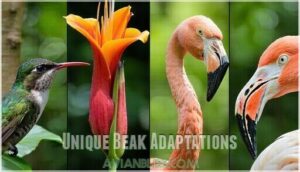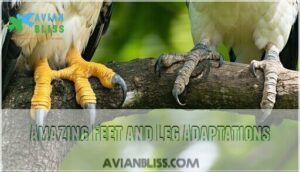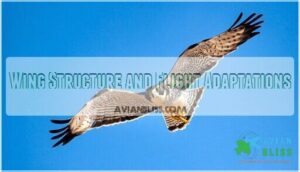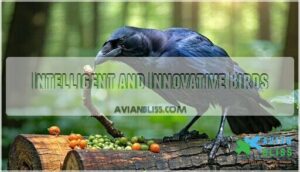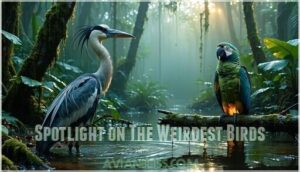This site is supported by our readers. We may earn a commission, at no cost to you, if you purchase through links.
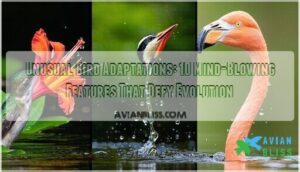 You’ll be amazed by unusual bird adaptations that help these feathered friends thrive in challenging environments.
You’ll be amazed by unusual bird adaptations that help these feathered friends thrive in challenging environments.
The sword-billed hummingbird sports a bill longer than its body, perfect for reaching deep into flowers. Flamingos eat upside-down, filtering food through specialized beaks. Woodpeckers have built-in shock absorbers in their skulls—like wearing a helmet 24/7!
Owls can rotate their heads nearly 270 degrees, while black-necked stilts walk on legs that make up 60% of their height.
These remarkable features didn’t happen overnight; they’re the result of millions of years of fine-tuning. Nature’s engineering gets even more impressive up close, with specialized beaks being a key adaptation.
Table Of Contents
- Key Takeaways
- Evolution of Unusual Bird Adaptations
- Unique Beak Adaptations
- Amazing Feet and Leg Adaptations
- Feathered Wonders
- Wing Structure and Flight Adaptations
- Talon Adaptations for Hunting and Defense
- Intelligent and Innovative Birds
- Behavioral Adaptations for Survival
- Conservation of Unusual Bird Species
- Spotlight on The Weirdest Birds
- Frequently Asked Questions (FAQs)
- What are some examples of bird adaptations?
- How do birds adapt to survive?
- Why do birds have foot adaptations?
- How are birds adapted for flight?
- How do bird adaptations help Feathered Friends thrive?
- What adaptations do birds have in their forelimbs?
- What are the unique adaptations of birds?
- What is unusual behavior of birds?
- What are five adaptations of a bird?
- What are the unique adaptations of birds that allow them to fly?
- Conclusion
Key Takeaways
- You’ll find bird beaks are specialized tools for survival, from the sword-billed hummingbird’s bill that’s longer than its body to the upside-down feeding mechanism of flamingos.
- Birds’ feet have evolved for specific purposes – waders have spread-out toes for balance in marshes, swimmers have webbed feet for propulsion, and climbers possess zygodactyl feet with toes arranged for gripping.
- Wing structure combines hollow bones with specialized primary and secondary feathers, creating different flight capabilities that vary by species – from soaring albatrosses to darting hummingbirds.
- You’ll be surprised by birds’ intelligence, with species like New Caledonian crows crafting tools, cockatoos solving complex locks, and vultures dropping bones onto rocks to access marrow.
Evolution of Unusual Bird Adaptations
You’ll be amazed at how birds evolved from dinosaur ancestors into the incredible flying creatures with unusual adaptations we see today.
From hollow bones that help with breathing (not just flight) to specialized beaks that work like Swiss Army knives, these adaptations show nature’s brilliant solutions to survival challenges over millions of years, demonstrating incredible flying creatures.
From Dinosaurs to Modern Birds
Within the shadow of extinction, theropod dinosaurs left clues to remarkable bird origins we see today.
Through fossil evidence, you can track this stunning transformation from reptiles to modern flyers.
The journey from dinosaur to bird included:
- Lightweight hollow bones enabling flight
- Feathers evolving from scales for insulation before flight
- Gradually shrinking bodies perfect for aerial life
These unusual bird adaptations showcase nature’s most dramatic evolutionary story. This was partly due to paedomorphosis in skull.
Key Transitional Features
Nature’s dinosaur-to-bird metamorphosis showcases remarkable transitional features that reveal evolution in action.
The famous Archaeopteryx fossil bridges the gap between theropod ancestry and modern birds, displaying both reptilian and avian adaptations.
| Feature | Function | Example Species |
|---|---|---|
| Feather Evolution | Insulation before flight | Microraptor |
| Hollow Bones | Weight reduction | Confuciusornis |
| Fused Wishbones | Flight stability | Archaeopteryx |
You’ll notice these skeletal changes weren’t random—they followed clear patterns optimizing for flight origins. Bird embryos still develop and then lose dinosaur-like features during development, a fascinating glimpse into their evolutionary past.
Transitional fossils continue to fill gaps in our understanding, showing how dinosaur descendants gradually developed the lightweight frames and specialized feathers necessary for conquering the skies.
Impact of Environmental Pressures
From dinosaur features to survival tricks, environmental pressures have shaped birds in surprising ways.
You’ll spot these evolutionary adaptations everywhere:
- Habitat Loss forces birds to shrink in size, with smaller bodies helping them shed heat in warming environments
- Climate Change alters migration timing, often too quickly for birds to keep pace
- Food Scarcity prompts bet-hedging strategies, with longer lifespans in variable environments
- Predator Defense requires constant innovation as natural landscapes change
These survival challenges push birds’ adaptations to mind-blowing extremes.
As <strong>bird habitats change</strong>, species are forced to adapt or face decline.
Unique Beak Adaptations
You’ll find that bird beaks are nature’s Swiss Army knives, perfectly shaped for specific jobs from cracking tough seeds to filtering tiny organisms from mud.
When you look closely at a flamingo’s comma-shaped bill or an eagle’s sharp hook, you’re seeing millions of years of adaptation that helps each species thrive in its unique ecological niche.
Seed-Eating Birds
When you examine seed-eating birds up close, you’ll discover their beak morphology isn’t just fascinating—it’s a masterpiece of natural engineering.
| Bird Type | Beak Shape | Seed Preferences |
|---|---|---|
| Cardinals | Thick, conical | Hard-shelled sunflower seeds |
| Finches | Short, pointed | Small, soft seeds |
| Crossbills | Crossed mandibles | Conifer cone seeds |
These specialized tools crack open nature’s toughest packages with surprising efficiency. You might notice a goldfinch’s delicate beak perfectly extracts tiny seeds from thistles, while a grosbeak’s powerful bill snaps cherry pits like they’re popcorn!
Bird diet adaptations extend beyond beaks—their foraging behavior and digestive adaptations work together in perfect harmony. Many species have specialized tongue structures and muscular gizzards that grind seeds after swallowing.
This unique beak functionality doesn’t just guarantee survival—it shapes entire ecosystems through seed dispersal, creating a habitat impact that extends far beyond the birds themselves.
Meat-Tearing Raptors
Wielding nature’s most impressive toolset, raptors showcase specialized meat-tearing adaptations that’ll leave you amazed.
Their hooked beaks work like surgical knives, slicing through flesh with precision.
- Talon strength lets eagles exert up to 400 pounds of pressure per square inch
- Specialized digestive systems process raw meat efficiently
- Lightweight skeletal adaptations balance power with flight ability
- Enhanced sensory acuity helps spot prey from remarkable distances
You’re witnessing perfect carnivorous engineering!
Filter-Feeding Specializations
With their bill turned upside-down, flamingos showcase nature’s most impressive filter-feeding specializations.
Their unique beak morphology includes tiny comb-like structures called lamellae that act as sieves for water processing. You’ll find these bird adaptations perfect for extracting nutrients from muddy water, where they capture tiny shrimp, algae, and other small prey.
Ducks also employ this clever technique, using specialized bill structures to strain food from water. These unique bird features demonstrate how beak adaptations perfectly match habitat specificity and prey selection.
Amazing Feet and Leg Adaptations
You’ll find birds’ feet and legs are specialized tools that help them thrive in environments from muddy swamps to icy branches.
From the Philippine Eagle’s powerful talons that exert 500 pounds of pressure to the zygodactyl feet of woodpeckers with two toes forward and two backward for climbing, these adaptations showcase nature’s remarkable engineering.
Wading and Perching Birds
Through specialized feet adaptations, birds have mastered life in diverse habitat niches.
Wading birds like herons and egrets balance on marshy ground with remarkably long, spread-out toes that distribute weight – nature’s own snowshoes! Meanwhile, perching birds can literally sleep on branches thanks to tendons that automatically lock their toes around perches.
- Foraging strategies depend on these specialized feet – some wade through mud for fish, others grip branches to reach fruit
- Social behavior influences foot design – birds that flock together need different balance than solitary hunters
- Nesting habits correlate with foot structure – birds who nest in trees need powerful gripping feet
Webbed Feet for Swimming
While wading birds excel on marshy ground, swimming birds showcase nature’s perfect design with their webbed feet.
You’ll notice several webbing types that provide remarkable aquatic locomotion. These feet adaptations create natural flippers for powerful foot propulsion through water.
This evolutionary advantage isn’t just clever—it’s genius! Ducks, geese, and swans transform ordinary toes into specialized paddles, maximizing swimming efficiency with minimal effort.
Grasping and Climbing Abilities
The incredible grip mechanisms of climbing birds would amaze any backyard birdwatcher.
Parrots showcase zygodactyl feet—two toes forward, two backward—enabling superb branch grasping and arboreal locomotion.
Woodpeckers rely on pointed claw structure to scale vertical trunks without falling.
These unusual bird adaptations maximize both stability and mobility in treetop environments.
- Leg muscles power the toe grip mechanism that lets birds sleep on branches without falling
- Parrots’ feet function like natural "lock-grips" for hanging upside-down
- Climbing birds achieve impressive grip strength with minimal effort
- Specialized feet adaptations evolved specifically for life in the trees
Feathered Wonders
You’ll discover bird feathers aren’t just for flying but serve as remarkable tools for attracting mates, providing camouflage, and maintaining body temperature.
These intricate structures, composed of barbs and barbules that interlock like tiny zippers, help birds thrive in diverse environments from the freezing Arctic to scorching deserts, and are a key factor in their ability to maintain body temperature.
Attractive Plumage for Mating
Five dazzling plumage displays can make you rethink bird feathers.
Males typically sport vibrant feathers while females remain dull—a classic case of sexual dimorphism.
You can’t see what they see; birds detect ultraviolet coloration invisible to humans.
Male tanagers use microstructures that reflect light, creating iridescence that’s like nature’s disco ball.
Female fairywrens aren’t fooled by looks alone; they prefer specific red-black patterns.
When birds-of-paradise perform their intricate mating dances, their feathers aren’t just pretty—they’re evolutionary matchmakers.
Camouflage and Stealth
While mating plumage dazzles, nature’s master illusionists use camouflage for survival.
Birds have perfected the art of disappearing through cryptic coloration and habitat matching.
- Ptarmigans change from brown to white seasonally, matching their surroundings
- Bitterns stretch upward with striped plumage, mimicking reeds perfectly
- Nightjars’ disruptive markings break up their outline on forest floors
- Great potoos look exactly like broken tree stumps – you’d walk right past them!
Bird predator avoidance isn’t just about hiding. It’s behavioral too. Some species freeze in place, turning plumage patterns into perfect invisibility cloaks.
Insulation and Flight Efficiency
While birds master camouflage through clever disguises, their feathers serve another brilliant purpose—keeping warm while staying airborne.
You’ll notice birds don’t shiver in winter storms. Their feather insulation works like your favorite down jacket, trapping warm air close to their bodies. Meanwhile, their lightweight bone structure makes flight possible without sacrificing strength.
| Feature | Function | Fun Fact |
|---|---|---|
| Contour Feathers | Aerodynamic shape | Reduce drag by 25% |
| Down Feathers | Thermal regulation | Can insulate in -40°F |
| Hollow Bones | Weight reduction | Strong despite being hollow |
| Wing Loading | Balance lift/weight | Varies by species |
| Airflow System | One-way breathing | More efficient than mammals |
Birds’ flight adaptations aren’t just cool engineering—they’re survival tools. Their feather structure creates perfect aerodynamic lift while maintaining insulation, a balance few other creatures achieve.
Wing Structure and Flight Adaptations
You’ll be amazed how bird wings combine hollow bones and specialized feathers to achieve flight capabilities that even modern aircraft can’t match.
Their wing shapes vary dramatically across species, from the wide soaring wings of eagles to the narrow, speedy wings of falcons, each perfectly adapted to their hunting style and habitat.
Lightweight Yet Strong Bones
The magic of avian flight doesn’t just come from feathers.
Looking inside a bird’s skeleton reveals one of nature’s cleverest designs: hollow bones.
Unlike solid mammal bones, birds evolved bone pneumatization—a system where air sacs extend into the skeleton.
These lightweight yet strong bones feature internal struts for structural integrity without unnecessary weight.
The fused skull bones and specialized sternum create a rigid framework that enhances flight efficiency.
This remarkable skeletal fusion boosts avian agility, allowing birds to execute those mid-air maneuvers you’ve witnessed with amazement.
Primary and Secondary Feathers
While hollow bones provide the framework, a bird’s feathers are the true marvels of flight engineering.
The flight feathers on birds’ wings work like precision instruments:
- Primary feathers at wing tips create thrust and control speed
- Secondary feathers closer to the body generate lift and stability
- Flight feathers have asymmetrical shapes that create airfoil effects
- Regular molting guarantees peak feather functionality through seasonal replacements
These specialized feathers evolved from simple scales to become nature’s perfect flight mechanism, guaranteeing the best performance.
Wing Shape and Size Variations
Beyond just having feathers, you’ll find that wing shape and size variations determine exactly how birds fly.
Ever wonder why an albatross can soar for days while hummingbirds dart quickly? It’s all about aspect ratio and wing loading.
Birds with high aspect ratio wings (long and narrow) like seabirds excel at soaring, while hawks with moderate wings balance speed and maneuverability.
The relationship between wing surface area and body weight creates different flight styles.
When examining avian flight mechanics, you’ll notice specialized adaptations everywhere. Falcons have pointed wingtips for speed, while eagles have slotted wing edges to reduce turbulence.
These small differences generate massive impacts on aerodynamic lift.
During migration, distance travelers like arctic terns develop wings perfectly suited for their incredible journeys—nature’s own perfectly engineered flight machines.
Talon Adaptations for Hunting and Defense
You’ll be amazed at how birds’ talons have evolved into precision weapons that can pierce, grip, and crush with incredible force.
These specialized claws, from the harpy eagle’s five-inch daggers to the Philippine eagle’s vise-like grip that exerts 500 pounds of pressure, showcase nature’s engineering at its finest.
Sharp and Curved Claws
While wings let birds rule the skies, it’s their talons that make them formidable hunters.
You’ll find nature’s most impressive tools at the end of birds’ legs. These sharp, curved claws function like precision instruments, with grasping strength that can crush prey instantly.
Eagles’ talons exert pressure exceeding 400 pounds per square inch! Their curved design creates a natural prey capture system that’s nearly impossible to escape.
- Fun fact: The harpy eagle’s talons are larger than a grizzly bear’s claws, measuring up to 5 inches long!
Powerful Leg Muscles
Take a look at those remarkable raptors like hawks and eagles—their dominance comes from powerful leg muscles packed into their relatively small frames.
These muscles deliver impressive force, enabling birds to snatch prey with crushing strength. The Philippine Eagle, for example, can exert 500 pounds of pressure when grasping prey!
| Trait | Function | Example Bird | Fun Fact |
|---|---|---|---|
| Leg Strength | Launch & grab prey | Hawk | Can crush with 200 psi force |
| Muscle Anatomy | Precision & control | Owl | Helps maintain stealth during strikes |
| Jumping Ability | Hunt or escape | Falcon | Boosts dive start speeds |
| Climbing Adaptations | Vertical movement | Woodpecker | Perfect for scaling trees |
These amazing feet and leg adaptations showcase how evolution has fine-tuned bird foot structures for everything from ground foraging to grasping and climbing abilities, highlighting the importance of leg muscles and climbing adaptations in their daily activities.
Specialized Talon Shapes and Sizes
A bird’s talons tell a fascinating survival story, with shapes and sizes perfectly matched to their hunting needs.
These specialized claws have evolved over millions of years to give birds incredible grasping power.
- Harpy eagles have massive talons (up to 5 inches long) for capturing large prey like monkeys
- Owls possess serrated edges on their claws for enhanced grip during nighttime hunts
- Woodpeckers have curved, sharp talons that act as natural climbing equipment
Intelligent and Innovative Birds
You’ll be amazed at how birds can use tools and solve complex problems just like humans do, with crows fashioning sticks into hooks and cockatoos picking locks.
Their remarkable intelligence isn’t just for show—it helps them find food, escape predators, and adapt to changing environments in ways that challenge our understanding of bird brains, showcasing their ability to use tools.
Tool Use in Wild Birds
Tool use in wild birds is a fascinating demonstration of avian intelligence and adaptation. When food becomes challenging to access, certain bird species show remarkable innovation by using objects in their environment as tools.
While sharp talons serve many birds well, some species display remarkable tool-use evolution that’ll leave you amazed. You’re witnessing cognitive abilities that challenge our understanding of avian intelligence.
| Bird Species | Tool Used | Purpose |
|---|---|---|
| New Caledonian Crows | Modified sticks | Extract insects from bark |
| Egyptian Vultures | Rocks | Crack open ostrich eggs |
| Goffin’s Cockatoos | Wooden splinters | Extract seeds from fruit |
| Burrowing Owls | Animal dung | Attract insects as bait |
| Herons | Bread, insects | Lure fish to water’s surface |
This learned behavior isn’t just fascinating—it demonstrates problemsolving abilities that help birds adapt to challenging environments. To further stimulate these behaviors, owners sometimes use specialized foraging devices. When resources become scarce, these intelligent and innovative birds develop unique adaptations for food gathering, proving they’re far more clever than they first appear.
Problem-Solving Abilities
While some birds use tools, it’s their problem-solving abilities that truly showcase their smarts.
You’ll be amazed at how these feathered geniuses demonstrate cognitive flexibility when facing environmental challenges.
New Caledonian crows don’t just use tools—they modify them to better extract insects from tree bark. Keas in New Zealand have mastered innovation strategies, figuring out complex locks to access food rewards.
Through social learning, birds pass these clever tactics to others in their flock. A study found that great tits learned to pierce milk bottle caps by watching others succeed.
Even without formal training, intelligent and innovative birds develop unique solutions: vultures drop bones onto rocks to access marrow, while herons use bread as bait to lure fish. Their adaptability isn’t just impressive—it’s essential for survival.
Adaptations for Food Gathering
Nature’s foraging champions employ incredible food-gathering techniques that showcase evolutionary brilliance.
Birds’ feeding innovations include:
- Crows’ traffic collaboration, dropping nuts for vehicles to crack
- Woodpeckers’ specialized tongues extending inches beyond their beaks
- Filter-feeding flamingos with unique beak morphology for sifting mud
- Shrikes impaling prey on thorns as "larders" for food storage
These diet specializations highlight how beak adaptations and hunting techniques have evolved to maximize survival in diverse environments. Many birds also rely on plumage for camouflage to aid in sneaking up on prey, utilizing evolutionary brilliance to ensure their survival, and showcasing their food-gathering techniques in various environments, with a focus on maximize survival.
Behavioral Adaptations for Survival
You’ll be amazed by the clever survival tricks birds have developed, from elaborate mating dances to sophisticated territorial songs.
When you watch birds in your backyard, you’re actually witnessing millions of years of behavioral evolution that’s helped these feathered survivors thrive in nearly every environment on Earth.
Mating and Courtship Displays
Courtship displays transform ordinary birds into feathered Romeos and Juliets, each with unique ways to woo potential mates.
- Birds-of-Paradise: Males flash brilliant plumage signals while performing ritualized dances on carefully chosen display grounds.
- Bowerbirds: Build elaborate "love nests" decorated with colorful objects to impress females.
- Manakins: Perform synchronized group dances with lightning-fast wing snaps.
- Sage Grouse: Inflate specialized throat sacs while emitting bizarre popping sounds.
These impressive mating rituals showcase bird sexual selection in action.
Territorial Defense and Aggression
When two birds lock eyes across a shared boundary, you’re witnessing territorial defense in action.
Robins patrol borders with distinct songs, while falcons execute dramatic dive-bombs against intruders.
This intraspecific competition isn’t just for show—it’s about resource defense and survival.
Bird Species Territorial Marker Aggression Level Unique Behavior
Migration and Flocking Behaviors
When you watch birds soaring in V-formations along the Pacific Flyway, you’re witnessing remarkable evolutionary adaptations. These social flocking behaviors aren’t just pretty—they’re survival strategies.
Birds track resources and avoid predators through migration patterns guided by stars, magnetic fields, and landmarks. They’ll fly thousands of miles along migratory routes, using navigation strategies passed down through generations.
Swarm intelligence enables collective decision-making without a central leader. Working together conserves energy and guarantees collective safety during these incredible journeys.
Conservation of Unusual Bird Species
You’ll need to protect the world’s strangest birds if you want future generations to marvel at their mind-blowing adaptations.
Many unusual species with specialized beaks, feet, and feathers now face extinction due to habitat loss, climate change, and human activities, which threatens the survival of these birds with specialized beaks.
Threats to Weird Bird Populations
While you’ve been admiring strange birds’ behaviors, these unusual species face mounting threats in today’s world.
Habitat loss remains the primary danger as deforestation and agricultural expansion destroy critical ecosystems. Climate change compounds these issues by altering migration patterns and food availability.
Invasive species prey on eggs and compete for resources, while pollution impact damages health and reproduction. Hunting pressure still threatens rare species with distinctive features.
To combat habitat loss, NAWCA grants support wetland restoration projects. These weird bird populations—from filter-feeders to climbing specialists—require urgent conservation efforts to survive, especially since many already have precarious population numbers.
Habitat Restoration and Protection
While unusual bird species face mounting threats, habitat restoration and protection offer powerful solutions.
Restoring degraded ecosystems provides sanctuary for birds with specialized adaptations, including:
- Converting abandoned farmland into wetlands helps filter-feeding species thrive
- Replanting native vegetation creates corridors for birds with unique locomotion adaptations
- Establishing protected areas shields climate-sensitive nesting grounds
These conservation strategies combat habitat loss while preserving the remarkable diversity of avian adaptations that have developed over millions of years. Many groups offer products aiding restoration.
Community Engagement and Education
Throughout communities worldwide, bird conservation thrives on education and public involvement. You don’t need to be an expert to make a difference!
- Join local Birdwatching Clubs that combine fun outings with Conservation Advocacy work
Habitat protection becomes everyone’s responsibility when School Programs teach children about unusual avian adaptations. Community engagement often starts with simple Citizen Science projects like counting backyard visitors.
Online Resources make wildlife conservation accessible, while neighborhood education events spotlight threatened species. Your participation matters—whether it’s setting up feeders or volunteering at sanctuaries, you’re helping preserve these incredible winged wonders.
Spotlight on The Weirdest Birds
You’ll meet birds so bizarre that you’ll question everything you thought you knew about feathered creatures.
From the prehistoric-looking Shoebill with its hammer-shaped bill to the flightless, nocturnal Kakapo that smells like honey, these weird wonders showcase nature’s most creative adaptations.
The Shoebill Stork
After our thorough examination into conservation, let’s marvel at nature’s oddity: the Shoebill Stork. You’re looking at a bird that seems plucked from Jurassic Park!
With its massive shoe-shaped bill (hence the name), this African wetland resident is a master of patience.
The Shoebill’s unique anatomy isn’t just for show—it’s perfectly designed for hunting lungfish and catfish in muddy waters. They’ll stand motionless for hours before striking with lightning speed.
This unusual bird adaptation makes them successful ambush predators.
Sadly, their specialized habitat requirements have led to vulnerable conservation status as wetlands disappear. The Shoebill’s strange appearance hides a bird perfectly tuned to its environment.
The Kakapo and Its Nocturnal Habits
Five surprising ways the kakapo, New Zealand’s pudgy green parrot, survives without flight in the dark:
- Nocturnal Vision helps it navigate forest floors while other birds sleep.
- Flightlessness Impact means it’s developed strong legs for climbing and walking miles.
- Avian Camouflage includes moss-green feathers that blend perfectly with foliage. Many find comfort in owning a kakapo themed plushie.
- Mating Calls echo through mountains during their unique lek-breeding rituals.
- Conservation Efforts are essential as these freeze-when-threatened birds need protection from introduced predators.
The Hoatzin and Its Unique Digestive System
The marvel of Hoatzin evolution lies in its cow-like digestive system, a truly peculiar adaptation among birds.
This feathered oddity processes its leafy diet through:
- Foregut fermentation that breaks down vegetation using beneficial bacteria
- Bacterial symbiosis in its enlarged crop, comprising 77% of its total gut capacity
- Digestive efficiency specialized for fermenting tough leaves, similar to mammals
- Diet specificity that allows it to thrive on vegetation other birds can’t digest
You’ll smell Hoatzins before seeing them—they’re nicknamed "stinkbirds" for their fermentation odor.
Their chicks also possess wing claws, a feature lost in most modern birds.
Frequently Asked Questions (FAQs)
What are some examples of bird adaptations?
Birds are nature’s ultimate engineers.
Flamingos filter-feed with curved beaks, owls snag prey with sharp talons, and woodpeckers drill using zygodactyl feet.
Hollow bones, camouflaging feathers, and efficient lungs all fuel their survival adaptations.
How do birds adapt to survive?
To survive, birds evolve clever adaptations like hollow bones for flight, colorful feathers for camouflage or mates, and specialized beaks for food.
Their feet even vary—some swim, others grip, and a few climb like pros!
Why do birds have foot adaptations?
Let’s face it, bird feet are nature’s Swiss Army knives.
They evolve based on survival needs, helping birds perch, wade, swim, or hunt.
From grappling talons to webbed paddles, their design matches the job perfectly!
How are birds adapted for flight?
To soar, birds combine lightweight bones, powerful muscles, and expertly curved wings creating lift.
Their feathers interlock like Velcro, managing airflow.
Even their lungs maximize oxygen! It’s like nature gave them an airplane engineer’s toolkit, with expertly curved wings.
How do bird adaptations help Feathered Friends thrive?
From sharp talons to hollow bones, birds’ adaptations are like nature’s Swiss Army knife, helping them hunt, fly, and stay cozy.
Beaks, feathers, and feet evolve perfectly for their habitat, ensuring survival and success.
What adaptations do birds have in their forelimbs?
Birds’ forelimbs evolved into wings, giving them the ability to fly.
Hollow bones make them lighter, while feathers generate lift.
Joints and muscles in wings create power and precision, turning air travelers into expert pilots with wings.
What are the unique adaptations of birds?
Like nature’s engineers, birds boast hollow bones for lightweight strength, zygodactyl feet for climbing, and feathers for flight, warmth, and waterproofing.
Their diverse beaks evolve for specialized feeding, all driven by survival’s endless creativity!
What is unusual behavior of birds?
You’d be amazed by birds’ wild antics, like bowerbirds crafting fancy twig mansions to woo mates or penguins proposing with pebbles.
Some crows even use tools.
It’s like nature’s got its own game show!
What are five adaptations of a bird?
You’ve probably noticed birds soaring overhead.
Their five key adaptations include hollow bones for lightweight flight, specialized beaks for feeding, webbed or taloned feet for movement, efficient respiratory systems, and insulating feathers for protection.
They have these adaptations for efficient respiratory systems, which is crucial for their survival.
What are the unique adaptations of birds that allow them to fly?
You’ll find that hollow bones, powerful flight muscles, and specialized feathers allow birds to soar.
Their efficient respiratory system, streamlined bodies, and lightweight skeletons with internal struts complete these incredible adaptations.
Conclusion
Like a master artisan’s workshop, nature has crafted unusual bird adaptations that continue to surprise scientists.
You’ve now glimpsed the incredible diversity of specialized beaks, talons, and behaviors that help birds thrive in challenging environments.
These adaptations didn’t develop by chance—they’re refined answers to specific survival challenges.
The next time you spot a bird, you’ll see more than just a flying creature; you’ll witness millions of years of evolutionary engineering at work.
- https://academy.allaboutbirds.org/
- http://projectbeak.org/adaptations/beaks_cracking.htm
- https://www.thespruce.com/bird-foraging-behavior-386457
- https://evolution-outreach.biomedcentral.com/articles/10.1007/s12052-009-0133-4
- https://www.scientificamerican.com/article/how-dinosaurs-shrank-and-became-birds/

